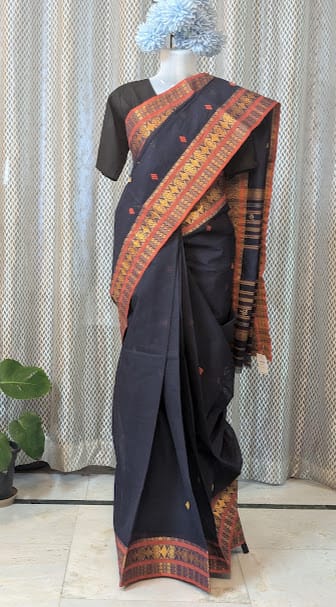
A Handloom Legacy of Bengal
Dhaniakhali sarees, one of Bengal’s most treasured handloom creations, have a history dating back over a century. Originating from Dhaniakhali, a small town in Hooghly district, West Bengal, these sarees are known for their fine cotton texture, intricate patterns, and durability. Woven entirely by hand, the making of a Dhaniakhali saree is a labor-intensive process that involves expert craftsmanship and dedication.
At Urban Shilp, we bring you authentic Dhaniakhali sarees, woven by skilled artisans who have been perfecting this craft for generations. Let’s take you behind the scenes to understand the artistry and effort that goes into weaving these timeless sarees.
Step 1: Sourcing the Best Cotton Threads
The journey of a Dhaniakhali saree begins with high-quality cotton yarn, which is sourced from different regions of India. The cotton threads are carefully chosen based on their strength and texture to ensure breathability and long-lasting durability.

Step 2: Preparing the Yarn – Dyeing & Drying
Before the weaving process begins, the cotton yarns are dyed in natural or chemical colors depending on the design requirements. Traditional Dhaniakhali sarees are known for their vibrant hues like red, blue, green, yellow, and mustard, often contrasted with white or off-white bases.
Once dyed, the threads are hung in open air to dry, ensuring a uniform color spread. This step requires patience, as the drying process must be carefully monitored to prevent uneven shades.


Step 3: Setting Up the Handloom
The dried threads are then arranged on a handloom, where the weaving process begins. The setup involves:
✅ Warping – Arranging the threads lengthwise.
✅ Wefting – Placing horizontal threads to create patterns.
✅ Tensioning – Adjusting the thread tension to ensure even weaving.
The weaver, often working from home or in a local handloom cluster, meticulously arranges each thread to maintain symmetry and accuracy in patterns.

Step 4: Weaving the Saree – The Magic of Handloom
Dhaniakhali sarees are known for their tightly woven texture, making them more durable than other Bengal cotton sarees. The weaving process can take anywhere between 2 to 5 days depending on the complexity of the design.
Popular patterns include:
🔸 Thin vertical stripes
🔸 Temple borders
🔸 Floral motifs (handwoven buti work)
🔸 Jamdani-style intricate designs
Each saree is woven using the throw-shuttle technique, where the weaver manually inserts the shuttle through the warp threads. Unlike power looms, handwoven sarees retain the unique human touch, making each piece one of a kind.

Step 5: Finishing Touches & Quality Check
Once the saree is woven, it undergoes a final inspection to ensure that there are no loose threads or weaving errors. The saree is then:
✔️ Trimmed and cleaned to remove extra threads.
✔️ Ironed and folded for a crisp, elegant finish.
✔️ Packaged with care before being sent to markets or online stores like Urban Shilp.
Why Choose a Handwoven Dhaniakhali Saree?
💖 Authentic Bengali Weave – A heritage textile crafted with skill and precision.
🍃 Eco-Friendly & Sustainable – Made using handlooms, not machines, reducing environmental impact.
🌞 Perfect for Indian Weather – Lightweight and breathable, ideal for summer.
👩🎨 Supports Artisan Communities – Buying handloom sarees helps sustain traditional weavers.
Conclusion – Own a Piece of Bengal’s Weaving Tradition
The making of a Dhaniakhali saree is not just about weaving fabric—it’s about weaving stories, traditions, and the hard work of skilled artisans. At Urban Shilp, we take pride in offering authentic handcrafted Dhaniakhali sarees, straight from Bengal’s finest weavers at Affordable Price.
✨ Explore our latest collection at affordable Price and bring home the charm of handcrafted elegance! ✨
📲 Shop Now: urbanshilp.com
📩 Follow us on Instagram: @urbanshilp
#UrbanShilp #DhaniakhaliSaree #BengalHandloom #HandloomSarees #SustainableFashion #SupportArtisans







Add comment